Simon Guerrier's Blog, page 3
July 29, 2025
Bellarion, by Rafael Sabatini
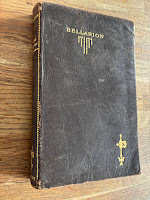 Until recently, I knew little about Rafael Sabatini (1875-1950), the best-selling author of swashbuckling, romantic adventures set in the past, such as Scaramouche (1921), Captain Blood (1922) and The Sea Hawk (1915 but overlooked until the 1920s). When Terrance Dicks was asked in an interview what his favourite books had been in childhood, he cited one by Sabatini:
Until recently, I knew little about Rafael Sabatini (1875-1950), the best-selling author of swashbuckling, romantic adventures set in the past, such as Scaramouche (1921), Captain Blood (1922) and The Sea Hawk (1915 but overlooked until the 1920s). When Terrance Dicks was asked in an interview what his favourite books had been in childhood, he cited one by Sabatini:“I was always a great reader when young. Kim, by Rudyard Kipling, which I read over and over again. A historical novel called Bellarion by Rafael Sabatini, which again I read time and time again. I think those are the two that came out most, as it were.” — Gareth Kavanagh, “Terrance Dicks”, Vworp Vworp! Volume Three (March 2017) p. 126.
When I visited Terrance’s home earlier this year, in pride of place in his study was a set of Sabatini’s novels, most of them in either brown or blue leather-bound editions published by the Phoenix Book Company Ltd of 3 & 4 King Street, Covent Garden, London — a company founded in 1928 and which “faded away” at some point during the war. Terrance’s copies are clearly well loved, Bellarion especially. But there’s nothing to tell us if this is the very book he read and reread as a child. He may well have bought these editions later in life and as a child borrowed and reborrowed Bellarion from his local library in East Ham.

Even so, I sourced a Phoenix Book Company edition of Bellarion for myself — in better nick than Terrance’s — and read it with great interest, hoping to understand why it made such an impression on him and whether it left any trace in Terrance’s own writing.
It begins pithily enough:
“‘Half-God, half-beast,’ the Princess Valeria once described him, without suspecting that the phrase describes not merely Bellarion, but Man.” (p. 9).
There’s a lot packed into this opening sentence. The contradiction in those first four words is intriguing. Then the name “Princess Valeria” suggests the kind of story this will be: history, fairy tale, romance. But we’re also being invited to question Princess Valeria’s judgment — and, surely, to make our own assessment of the titular Bellarion, whoever he may be, before we’ve even met him.
Sabatini clearly knew the importance of a good opening sentence, as we can see from what he said himself about the genesis of his most famous novel:
“I began by fastening upon a title, Scaramouche, and almost simultaneously came the phrase descriptive of the character: ‘He was born with the gift of laughter and a sense that the world was mad.’ That supplied the opening line and the keynote of the book. With so much in hand, the setting readily suggested itself. How the actual story came I do not know. But the seed and the soil were found, and the rest followed somehow.” — Sabatini, quoted in Herbert Greenhough Smith (ed.), What I Think — A Symposium on Books and Other Things by Famous Writers of To-Day (1927)
After its zinger of an opening line, Bellarion continues by telling us that what follows is drawn from a real, historical document attributed to a big name:
“It is more than probable that this study of Bellarion the Fortunate (Bellarione Fortunato) belongs to that series of historical portraits from the pen of Niccolo Macchiavelli, of which The Life of Castruccio Castracane is, perhaps, the most widely know. Research, however, fails to discover the source from which he draws. Whilst many of his facts agree completely with those contained in the voluminous monkish Vita et Gesta Bellarionis left us by Fra Serafino of Imola, whoever he may have been, yet discrepancies are frequent and irreconcilable.” (pp. 9-10)
But Fra Serafino of Imola is an invention of Sabatini, while the reference to Macchiavelli is surely a gag, because he’s thought to have made up large parts of his Life of Castruccio Castracani.
There’s more historicity peppered through this account of intrigues in Italy in the years 1407-1412. At one point, Sabatini supplies an “Englished” version of a rare surviving letter from Bellarion, preserved in the Vatican Library (p. 295). He compares an account given of an incident by Fra Serafino (him again) with that of real-life Milanese historian Bernardino Corio (p. 326) — which can’t really exist because the incident is invented. Sabatini responds to Bellarion’s “detractors” (p. 302), suggesting a host of historical sources and scholarly debate. We’re told that Bellarion’s military tactics are critiqued in L’Art Militaire au Moyen Age by M. Dévinequi (p. 386), but there’s no such book or historian, whose surname translates as “Guess who”.
Yet many of the characters here are real historical figures and Bellarion schemes his way through real history. The Visconti Castle of Pavi “as described by Petrarch” (p. 327) is a real place, and really was described by Petrarch in Letters of Old Age. The wholly fictional Bellarion has been inveigled into real history, just as the character inveigles his way into the various courts and councils.
So what of Bellarion himself? Our first impression is of a precocious, bookish teenager. Aged 17 in 1407, he has been brought up since the age of 6 by the abbot (!) in charge at the Convent of Our Lady of Grace of Cigliano, and is widely read but has little experience of the real world. That’s clear from the argument he has with the abbot, taking the logical but blasphemous view that because God can do no evil, He would not create sin or the Devil, and so neither of these things can exist.
Worn down by Bellarion’s recalcitrance, the abbot sends him away to be better educated. But on the way, the naive Bellarion falls in with a man claiming to be a friar but who we can see is a thief. After some comic episodes, Bellarion realises the truth — just as the friar is arrested. Accused of being the friar’s accomplice, Bellarion scarpers and, by chance, escapes into the garden of Princess Valeria. He lies to her about who he is, and finds himself quickly caught up in court intrigues and then bigger plots, battles and wars.
I can see why this lively, often funny tale about a bookish boy of modest background living on his wiles and running rings around the posh lot would appeal to the young Terrance Dicks. The dry humour is very him. For example, when Bellarion is on trial and facing sentence of death, his earlier (false) claim to be the adopted son of a nobleman makes his enemies pause.
“Thus it was demonstrated to Bellarion how much may hang upon a man’s wise choice of a parent.” (p. 123)
Perhaps some of the language rubbed off on Terrance, too — on p. 97, Valeria and Bellarion are mocked repeatedly as, “long-nose and long-shanks”.
“Is this Doctor a long-shanked rascal with a mighty nose?” — Irongron, Doctor Who — The Time Warrior, script editor Terrance Dicks
But then there’s the kind of hero Bellarion is.
“I grew up reading John Buchan, and Dornford Yates, and Rafael Sabatini, people like that, and I imbibed my ideas of what was right and proper – and the way an English gentleman should be – from my reading.” TD interviewed by Benjamin Cook, “He Never Gives In And He Never Gives Up…” Doctor Who Magazine #508 (2017).
Bellarion — an Italian — is not a fearsome warrior but a bookish, thoughtful man who aspires to be a monk.
“If I were your chronicler, Bellarion, I should write of you as the soldier-sage, or the philosopher-at-arms.” (p. 334)
He is a canny tactician and strategist, but not motivated by conquest, fortune or glory.
“‘Tell me why you so schemed and plotted.’
Bellarion sighed. ‘To amuse myself, perhaps. It interests me. Facino said of me that I was a natural strategist. This broader strategy upon the great field of life gives scope to my inclinations.’ He was thoughtful, chin in hand. ‘I do not think there is more in it than that.’” (p. 368)
He’s done all he’s done out of intellectual curiosity; because he was bored. He is prone, too, to what we might call moments of charm, such as when he disses an enemy:
“He assumed that I, too, had no aim but self-aggrandisement, simply because he could assume no other reason why a man should expose himself to risk.” (p. 79)
He’s brave and brilliant, moral and determined, and passes easily among dukes and princesses while not being quite of their kind. Like so often with Jon Pertwee’s Doctor, there’s a chapter where everyone thinks he is dead.
But that’s not to say that Bellarion is a prototype Pertwee Doctor. He is often impetuous, at one point murdering a man in cold blood who tries to rescue him, which causes no end of complications later. He’s also no good at combat; for all he is brave in executing his clever schemes, they are often a means to avoid his having to fight. On one occasion, he pretends to be ill to get out of a joust.
It’s also not very dramatically satisfying that his various schemes all succeed exactly as he predicts. In that sense, I think Terrance was better on the structure of this kind of adventure.
At the end, when Valeria finally realises that Bellarion is not the rogue she thought and kisses him, the romantic ending is punctured by a joke, or at least by downplaying the moment: the last line is Bellarion saying he must have a fever. Valeria isn’t the only woman to fall for Bellarion but it often seems that this is another kind of conflict for him to dodge.
It’s intriguing, too, that the title page calls this book Bellarion the Fortune. Is Bellarion lucky or does he make his own luck? That’s something Terrance Dicks thought about quite a bit when considering his own career… More of which anon.
July 23, 2025
Target Books Day audio recording
 I had a lovely time at Target Books Day on Saturday (19 July), organised by James Goss. He assembled a really fun, engaging series of talks and readings related to the Doctor Who novelisations, including me wanging on about Terrance Dicks - most prolific of the Target authors - and the early days of the range that launched in January 1974, alongside learned critiques and readings from new books that won't be published until next year.
I had a lovely time at Target Books Day on Saturday (19 July), organised by James Goss. He assembled a really fun, engaging series of talks and readings related to the Doctor Who novelisations, including me wanging on about Terrance Dicks - most prolific of the Target authors - and the early days of the range that launched in January 1974, alongside learned critiques and readings from new books that won't be published until next year.You can now listen to my talk, "The Unseen Terrance Dicks", and lots of the other contributions, as episodes of the Hamster with a Blunt Penknife podcast:
Target Book Club Part One on Apple, Podbean, Spotify
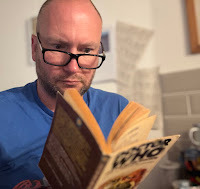 Gary Gillatt, "Opening Lines"
Gary Gillatt, "Opening Lines"Every first line of a Target novelisation, in publication order. Bliss.
Simon Guerrier, "The Unseen Terrance Dicks"
Jenny Colgan, reading from her forthcoming novelisation of 2010 TV episodes Time of Angels and Flesh and Stone
Mags L Halliday, "Romancing the Target"
Including much love for the loved-up work of David WhitakerTarget Book Club Part Two on Apple, Podbean, SpotifyRobert Shearman, reading from his forthcoming novelisation of 2002 audio play The Chimes of Midnight
John Grindrod, "Terror of the Blurboids"
On the changing face of back-cover blurbs
Nev Fountain, "The Policeman's Face Peeled Away"
On the work of illustrator Alan Willow
Dr Paul Quinn, "I See The Rumours About You Are True..."
On sexual predation in the TV version and novelisation of Ghost Light - requiring a trigger warningTarget Book Club Part Three on Apple, Podbean, SpotifyStephen Gallagher discusses and reads from the novelisation of his own 1980 TV story Warrior's Gate
Steve Cole, "The Wheel of Tara" aka confessions of a books editor
Alex Hewitt, "Reading Games with Pip and Jane"
On literary games for children written by Pip and Jane Baker years before they scrivened for Doctor Who
Joe Lidster reading from his forthcoming novelisation of 2005 TV story Alien of London and World War Three
Gareth L Powell reading from his newly published novelisation of 2025 TV episode The Well
James Goss reading from his newly published novelisation of 2025 TV episode Lux

July 22, 2025
Backlisted #244: The Ballad of Halo Jones
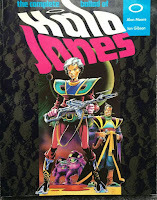 I'm the guest on the latest episode of books podcast Backlisted. Keen to choose a book that was a formative influence and by an author they'd not previously covered, I chose The Ballad of Halo Jones by Alan Moore and Ian Gibson. Thanks to Dr Una McCormack, Andy Miller and Nicky Birch for inviting me. What fun.Backlisted #244: The Ballad of Halo Jones by Alan Moore
I'm the guest on the latest episode of books podcast Backlisted. Keen to choose a book that was a formative influence and by an author they'd not previously covered, I chose The Ballad of Halo Jones by Alan Moore and Ian Gibson. Thanks to Dr Una McCormack, Andy Miller and Nicky Birch for inviting me. What fun.Backlisted #244: The Ballad of Halo Jones by Alan MooreIn our natter, we mention other works by Alan Moore. You might like to read the big essay I wrote for my MA on V for Vendetta.
The episode also mentions something that was announced on Saturday at the excellent Target Books Day: I am currently at work on a biography of Terrance Dicks, to be published by Ten Acre Films (who published by previous biography, David Whitaker in an Exciting Adventure with Television). More of all that anon.

July 21, 2025
Chapters of Accidents, by Alexander Baron
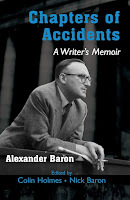 As expected, Alexander Baron’s autobiography confirms that various elements of his novel The Lowlife (1963) are based on real life: his own, his relatives’, his neighbours’. That image that so struck me of the continually rechalked squares for hopscotch, is mentioned here on p. 350. In fact, the autobiography — written in the 1990s — draws from his novels to recall events otherwise since forgotten, quoting From the City, From the Plough (1948) to recount Baron’s direct and harrowing experience of the D-Day landings.
As expected, Alexander Baron’s autobiography confirms that various elements of his novel The Lowlife (1963) are based on real life: his own, his relatives’, his neighbours’. That image that so struck me of the continually rechalked squares for hopscotch, is mentioned here on p. 350. In fact, the autobiography — written in the 1990s — draws from his novels to recall events otherwise since forgotten, quoting From the City, From the Plough (1948) to recount Baron’s direct and harrowing experience of the D-Day landings.The autobiography covers his early life as a working class boy from a non-practising Jewish immigrant family in Hackney up to the sale of his first novel. One note describes the sounds of the East London between the wars:
“‘Won’t you buy my pretty flowers?’, ‘I’ve been 7 years in prison…’. Other ballads — Victorian London, Dickens’ London — continued until the war scattered a way of life in 1939.” (p. 344)
It’s not the only reference to Dickens. For example, while his father read science books by such authors as James Jeans, Baron and his mum would visit the library on Northwold Road each week “with oilskin shopping bags”, where Baron read huge, bound volumes of adventure stories by GA Henty and Percy Westerman before progressing to PG Wodehouse’s PSmith.
“about one of the vast army of clerks which still existed, now swelled by women typists, who were the cleverer children of working-class families which were proud of their status (escaped!) Although almost all worked for wretched wages, often in Dickensian offices.” (p. 349)
Baron read some Dickens as a child, citing Barnaby Rudge and,
“its effect on me as a small boy — lurid, a phantasmagoria, those Gordon Riots — the unspeakable ecstasy of reading books you cannot understand when you are small” (p. 347),
He also speaks of the “effect on me” of The Pickwick Papers, while David Copperfield was a formative read while he was stationed in Southampton as a soldier during the war. I’m fascinated by that because Baron later dramatised Oliver Twist for the BBC, broadcast in 12 episodes in 1985. The novel was first published in 1838 but I wonder how much Baron and producer Terrance Dicks were conjuring the London of a hundred years later; the one they’d both known as children.
As with Terrance, cinema was another key influence on Baron — he explains, pp. p. 347-48, how it shaped the structure of his writing. But his literary interests had another powerful consequence: it was on a trip to a library while still at school that he was first enthralled by the communists. Though he didn’t join the Community Party officially at that point— they thought it better he didn’t so he could infiltrate the Labour youth movement instead — he was a keen adherent. They even sent this schoolboy revolutionary on an errand to France.
“It was of all days Yom Kippur, the supreme Jewish fast. My parents had taken my sister to the East End to visit my grandparents. I left a note on the kitchen table, ‘Gone to Paris. Back Monday.’ The reader would have to understand the nature of the times, the moeurs of a working-class Jewish family and the particular character of my parents to appreciate what a bombshell that was going to be for them, how incredulous they would be.” (p. 168).
When he returned, all that his parents asked of him was whether he had a nice time (p. 170).
There’s something a bit Boy’s Own adventure about much of this stuff, with brassneck and dodges and pluck — such as his role in the Labour League of Youth’s weekly street-corner meetings.
“I was too shy to speak at these, but I was given the job of heckling our own speakers to draw a crowd, which I enjoyed.” (p. 147)
It’s in the mode too, I think, of Kipling’s schoolboy stories, Stalky & Co, which Baron dramatised for the BBC, the first time he worked with Terrance Dicks.
On another occasion, Baron explains how one night he escaped a gang of young Fascists keen to beat him up by running on to Hampstead Heath then lying down with his arms around himself, so that he resembled one of the other copulating couples (p. 156). It’s another funny dodge — but a bit less heroic than what happens in The Lowlife, where the main character evades his pursuers thanks to a native grasp of London buses and trains, then beats them up single-handed.
Things become more serious as the war approaches. Baron speaks of his own horror at having to recruit men to fight in the Spanish Civil War — and his relief that he never succeeded. At the same time, he says how easily he might have done in Spain what a contemporary did, working for the Republican Army’s secret police (Servicio de Informaction Militar), befriending young soldiers and then reporting those who criticised the party. He cites another case, another friend, who was accused of writing “calumnious letters” home and seems to have been shot.
“I am an old man now but I am ridden by the memory of these distant events, of him and of Monty, the one murdered by the secret police, the other in their ranks, both brave, honourable in intent and so alike; and I am all the more fervently relieved that I did not send Bill Featherstone or anyone else to fight where I did not go myself.” (p. 181)
In all this and what follows, Baron doesn’t mention Malcolm Hulke, who must have been in and out of the King Street HQ of the Communist Party around the same time, and who he might just have bumped into after the war when they both worked in management at the Unity Theatre. Baron says that while he was at Unity,
“we wiped out a large and chronic debt, which must have been a feat unique both among fringe theatres and organisations of the left.” (p. 332)
In part, this organisation was because Baron avoided the “tantrums and cliques” of the actors; as with his reticence at public speaking cited before, he seems to have been a bit quiet and shy.
“My own nature kept me apart from a crowd who were serious in their intentions but involved withe all the scattiness and temperamental quirks that are to be found in theatricals.” (Ibid.)
There’s also the suggestion that he’d not been well after the war, suffering from some kind of PTSD. The war certainly had a profound effect on him, not least in undermining his communist zeal. There was no single cause but that loss of faith went in tandem with his new-found interest in writing. Soon after the war, he had a chance meeting with his old friend Ted Willis — who had also left the party to become a writer. Baron tells us that,
“This was a drastic step for a member of the inner core [of the party], since writing was regarded at King Street as a trifling and contemptible occupation.” (p. 331).
They referred to Ted as a “deserter”. Later, Baron explains why it was thought so contemptible, quoting what he was told by his former mentor John Gollan:
“What does a writer do, even a good writer, even one of ours? He describes the world. You are one of the people who have to change it. And one day to run it.” (p. 336)
I wonder how convincing Baron found this? Earlier, he speaks of the,
“Communist ability to show a fair face in any company, display charm, patience, reasonableness and willingness to listen and a persuasiveness that provide irresistible to many.” (p. 208)
If his first novel had not been a success, how easily might he have been drawn back into the fold?
For all he was compelled to write a novel based on his own wartime experience, Baron put it away in a drawer and says he later showed it to Ted Willis unwillingly. It was Willis and his wife who submitted it to Jonathan Cape, and Cape’s wife who came up with the title under which it was published.
Baron tells us that he thinks much of history is accidental like this — hence the title of this autobiography. But I think something else is going on: this is a bildungsroman, showing the development of a man’s character through his experience and choices. When he bumps into Ted Willis after the war, its because Baron has chosen to buy a typewriter — that choice surely compelled the conversation that followed. Willis, facing the opprobrium of his former comrades, must have been glad to find in Baron a fellow scribe. And what Baron went on to wrote was infused with all the things he’d soaked up in Dickens and cinema and the life he’d lived.
His escape was no accident at all.
July 15, 2025
The Curious Incident of the Dog in the Night-Time, by Mark Haddon
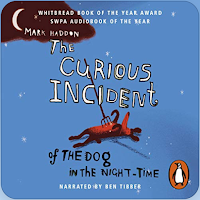 I first read this an age ago, before I had children or that much knowledge of autism. It's been a strange thing to revisit now I have more experience.
I first read this an age ago, before I had children or that much knowledge of autism. It's been a strange thing to revisit now I have more experience. This audio version is largely narrated by Ben Tibber as 15 year-old protagonist Christopher Boone from Swindon, but with a full cast playing the other characters. That works very well. We see (or hear) events as Christopher understands them. He has an eye for and takes satisfaction in detail, and we often get raw, unembellished facts, whether about his own anxieties and bodily functions or grown-ups' sex lives, swearing and violence.
His hyper-focus on particular things - prime numbers, colours, smells - and his bluntness are often funny. I've seen some readers object to this, feeling that we are led to laugh at Christopher. But I think something else is going on; we laugh because we understand the way he sees the world. It comes about through empathy.
That, I think, plays off against the more disturbing stuff. The world is a scary place. A whole load of things terrify Christopher (noises, strangers, things that are brown) and sometimes leave him unable to speak (except to us). There are also a whole load of things that he doesn't quite comprehend - but we do as readers.
Reading the book again now, what strikes me is how many of the characters are cross, impatient, at the end of their tether and sometimes downright cruel. That's in direct contrast to us as readers, comprehending of and amused by this boy. We embrace the ways he thinks differently; they just lose their tempers.
Christopher can certainly be exasperating and exhausting, and the grown-ups are fallible, flawed people. There are things here I recognised as the parent of an autistic child. But the over-riding sense, I think, is one of sadness because Christopher is not exactly surrounded by kindness. There's a lot of chaos and argument (which I can empathise with) but not a lot of joy. As a result, I think we judge his parents, his neighbours, his teachers, the police... The empathy for him is not extended to them. And I think that's an an issue given that some of their bad behaviour is rather contrived.
I keep picking over a key element of the plot. As Christopher determinedly investigates the murder of his neighbour's dog, he unravels an audacious falsehood that has been told to him and others for some time. Yes, I can see how Christopher would be duped because he takes what he's told at face value. But that doesn't apply to anyone else: have they really not questioned or checked what has been said about something so fundamental? When the lie is exposed, is there no consequence for the liar? The school, the police, the neighbours... no one seems very bothered.
At the end, Christopher seems liberated by a number of things that have happened over the course of the story: his schoolwork, his trip to London, his unravelling of the mystery. He's written this account - this book - and feels he can achieve anything. I'd like to believe so but I'm not sure surviving an ordeal is the same as learning from it. What will he and those around him do differently to avoid another crisis, or deal with it better when it comes?
But I'm not sure if that's a criticism of the book or a sign of how much it got under my skin.
July 10, 2025
The Lowlife, by Alexander Baron
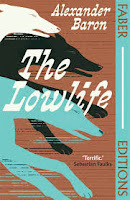 Harryboy Boas is a working-class gambler in Hackney. While his sister has married well and moved to Finchley, Harryboy still haunts the streets he knew as a kid, where hopscotch is still played in the same place, for all that the squares have been rechalked, sometimes on new tarmac. We feel the thrill of his addiction to gambling, and the shame of it, too. But he presents a good front to the woman he pays for sex, and to the uptight family that have just taken rooms in the shabby house he’s renting.
Harryboy Boas is a working-class gambler in Hackney. While his sister has married well and moved to Finchley, Harryboy still haunts the streets he knew as a kid, where hopscotch is still played in the same place, for all that the squares have been rechalked, sometimes on new tarmac. We feel the thrill of his addiction to gambling, and the shame of it, too. But he presents a good front to the woman he pays for sex, and to the uptight family that have just taken rooms in the shabby house he’s renting.Then, almost 100 pages in, we learn something else about Harry that helps explain what makes him tick. Before the war, he lived in Paris with a girl there. He thought about marrying her but when war broke out he went home to London. Only later, much too late, did he receive a letter saying she was pregnant. He and she are Jewish — and we never learn her fate.
So, he stalks the streets of London haunted by the Holocaust. He takes each day, each bet, as it comes, and tries not to get involved in anything more complex. But the little boy in the room downstairs has taken a shine to him…
The foreword to this edition is by Iain Sinclair, who — with filmmaker Chris Petit — visited Baron at home in Golders Green in 1992:
“The elderly author, unpublished since 1979, when his Spanish novel, Franco is Dying, met with the indifference that seems to be the lot of any awkward cuss who refuses to step aside when his humber’s up” (p. vi).
Characters in the novel might well speak of protagonist Harryboy as an “awkward cuss”, but we’re privy to his rich inner life, his passions for gambling, books and women, his strong survival instinct paired with a self-sacrificing moral core. He’s a loner in many ways, and one reason is because he is bookish.
“Among the uneducated (which frankly is what you would call the general population where I live) the serious reader is a lonely person. He goes about among the crowds with his thoughts stuffed inside him. He probably dare not even mention them to his nearest pals for fear of being thought a schmo. There’s a hunger in his eyes for someone to talk to.” (pp. 63-64)
Harryboy reads a great range of books. “Chandler and Hammett are my favourites,” he tells us (p. 63), at a time he’s working through everything by Zola. He holds forth on Upton Sinclair, HG Wells and George Simenon, and later on Nat Gould, Edgar Wallace and Damon Runyon. On p. 148, he’s reading Theodore Dreiser, on p. 211 he cites a poem by John Masefield. There are women writers, too:
“We were both at that time searching out psychological thrillers at the library, the kind the Americans do well, Vera Caspary, Patrica Highsmith and so on.” (p. 134).
It’s a diverse list of names but I wonder if they’re united by a naturalistic style, a focus on — or unwillingness to avoid — the grit and dirt of life.
That’s the kind of view we get of post-war London, particularly in all the stuff about the short-term investment in renting squalid building, which the council will surely soon condemn, to the new waves of immigrants. Sinclair says in his introduction that “Baron foresees Peter Rachman”, who died in 1962 — the year before The Lowlife was published — but became notorious as a slumlord after his death as the Profumo scandal broke. That makes the book exactly of its moment.
But I’m not sure this is a social realist or kitchen sink novel. It’s more of a thriller, the stakes every building against Harryboy, caught against his will in different, conflicting loyalties. There’s a theft, a chase and a violent punch-up, We really think at one point he is going to lose an eye.
And yet for all its an adventure, it feels very real — and is full of shrewdly observed detail. Many Londoners, Harryboy included, take the changing demographics of London in their stride, but Baron is good on the prejudice, too. It’s most directly seen in snobby neighbour Evelyn Deaner. At one point, we catch her horrified by the hats on women in the Daily Mirror.
“Can you imagine me wearing one? I think they must design these hats for exhibitionists.”
Then, from nowhere, she is “fighting for breath” in fury that their landlord let a room to a black couple.
“‘You know’ — she turned to me — ‘there’s only one water-closet in this house.’” (p. 125)
Later, she’s sure, on no grounds at all, that this couple eat “tinned cats’ mean” (p. 147) and mean to serve it to her son.
When Evelyn’s husband Vic tries to quell what Baron calls these “spasms of hate”, Evelyn tells him he doesn’t know what he’s talking about because he’s out of work all day.
“Suppose that man cam home early. Eh? Have you thought of that?”
And then, almost immediately:
“Please don’t tell me now that I’m prejudiced. I know there are good and bad. … What do you think I am — one of those colour-bar people? [But] this man is a labourer.” (p. 126)
It’s all unfounded and in her head; she’s conscious of it being unfair; it’s about class as much as ethnicity. There’s a lot bubbling up here, and Harryboy then makes his own connection:
“Sure, I nearly added, and these haters of life, they can even murder babies. Because that moment brought back to me like a twitch of pain in the head my fear that a little son of mine might have been packed into a dark, suffocating, sealed trunk for five days and nights and sent to the furnaces.” (p. 133).
It’s the mechanics of prejudice observed and relayed by a Jewish veteran of the war. The connection haunts him, and it haunt us, too.
I'm now reading Baron's autobiography, more of which anon...
July 9, 2025
My Baby Box, by Dr Debbie Challis
 The Dr has made available online the full text of her memoir, My Baby Box, which deals with her (our) experience of infertility, the death of our eldest daughter and a whole loads of things beside. Full text of My Baby Box, by Dr Debbie Challis
The Dr has made available online the full text of her memoir, My Baby Box, which deals with her (our) experience of infertility, the death of our eldest daughter and a whole loads of things beside. Full text of My Baby Box, by Dr Debbie ChallisBlurb as follows:
A portrait of Queen Victoria’s baby. Statistics on the fertility of educated women. Tokens left at the Foundling Hospital. Sunken headstones in a suburban cemetery. Tiny 4,000 year-old beads. A hippo amulet. The bones of a newly born child…
These are some of the things in My Baby Box, a memoir about my double loss. The loss after a diagnosis of infertility and the loss after the death of my unexpected baby.
It is also about my double love. The love found through adopting a child and then having a second baby who lived. It is about trying to become a mother through fertility treatment, approval from committees, getting to full-term pregnancy and giving birth safely, as well as what I have learnt about the historical context of what I went through. It is my account of trying to become a mother in early twenty-first century Britain and how I came to understand what happened to me through the things belonging to those who had been there before me, whether in Victorian Wigan or Ancient Egypt.
I've previously posted here about infertility and the loss of Emily.
July 4, 2025
Learning to Think, by Tracy King
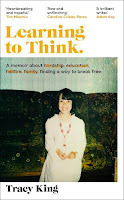 I’ve been blown away by this extraordinary, powerfully moving book, having met the author briefly at an event earlier this year. The subtitle says it’s “A memoir about” and then there are a series of crossed-out words: hardship, education, hellfire and family before it settles for “a way to break free.”
I’ve been blown away by this extraordinary, powerfully moving book, having met the author briefly at an event earlier this year. The subtitle says it’s “A memoir about” and then there are a series of crossed-out words: hardship, education, hellfire and family before it settles for “a way to break free.”
The blurb tells us more:
“Tracy King grew up on an ordinary council estate outside Birmingham. Her home life was filled with creativity, curiosity and love, but it was also marked by her father’s alcoholism and her mother’s agoraphobia.
“By the time she turned twelve her father had been killed, her sister taken into care and her mother ensnared by the promises of born-again Christianity.”
Roughly the first half of the book covers the author’s childhood and this series of traumas as she felt and understood them at the time. She’s very good on telling detail about people and place, so we know these individuals, we like them. We share their joys and small victories, we root for them, and feel their suffering and loss as awful things unfold. We are appalled by what happens in the trial of the people involved in killing her father.
In the second half of the book, we see the effect his death and these other things then have over the following years. It all casts an oppressive shadow but something else is also going on: the combined impacts of a love of reading and an interest in computers (both instilled by her late father), the opportunities offered by libraries and college, and then a rewarding job. At a key moment, she stumbles on a second-hand copy of The Demon-Haunted World by the astronomer Carl Sagan and it lights something inside her: a way of seeing and tackling the world that I think Sagan would call science but Tracy calls critical thinking.
Then, in the last, enthralling part of the book, Tracy applies critical thinking to that key trauma in her past life: the death of her beloved father. She reads the police report and dares to seek out and interview people involved, including the man who killed him. The result is suspenseful, brave, compassionate — and quite brilliant.
There’s no single, definitive account of what happened that night — not, as she says, without CCTV or her having being there herself — but she sifts the sometimes conflicting evidence and collates the most probable version. This is more than a coldly logical process; it’s driven by empathy and understanding. I’m reminded of of something I was once told at school, that “courage” literally means “of the heart”.
Much of what she describes here — not just about her father but other things such as the way education authorities treated her and her sister — is gruelling, often shocking. Yet the book is about her coming to terms with this stuff and the sense at the end is that the process brings her some peace.
At one point, she probes accounts of her father’s last moments, and whether he died instantly or not. She’s haunted by the suggestion of people there watching and doing nothing to help.
“There was nothing anyone could have done to save his life, Does it matter that a dead person was left alone for ten minutes? Is there dignity after death? Without a soul, a spirit, a ghost, does it matter whether anyone was with him while he lay on the cold concrete in the rain?
Of course it matters.
We can bear witness to his death now, through thee pages. Every reader is there with him. We outnumber the bystanders.” (p. 280).
What a privilege it has been to stand with her, to be part of that congregation.
In the epilogue, she links her past experience to the situation now, with school “refusal” (a term she critiques), increasing levels of poverty, and the closure of libraries and other kinds of support and opportunities that were so crucial to her. For all this is a memoir, it’s a book about how we moved forward from where we are now. I urge you to read it.
June 30, 2025
List of books by Terrance Dicks
Here is a work in progress: what I hope will be a definitive list a list of books written by the prolific Terrance Dicks. The Doctor Who books are well attested; it's working out where everything else fits that is proving a challenge. Hence me scouring the listings in the Bookseller.
Terrance tended to write in series, so here is my own key to those series:
DWs = Doctor Who specials [non-fiction]DWn = Doctor Who novelisations of TV storiesDWo = Doctor Who original novelsBSI = The Baker Street IrregularsOn that basis, here are his published works in order of publication: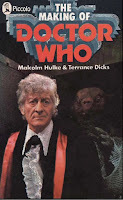 08 Apr 1972: [DWs #01] The Making of Doctor Who by Malcolm Hulke and Terrance Dicks, C8 120pp, 25p, Piccolo Books (Pan), Children's, ISBN 330 23203 7, listed in Bookseller 8 Apr 1972, p. 1,893.
08 Apr 1972: [DWs #01] The Making of Doctor Who by Malcolm Hulke and Terrance Dicks, C8 120pp, 25p, Piccolo Books (Pan), Children's, ISBN 330 23203 7, listed in Bookseller 8 Apr 1972, p. 1,893.Cover: photo of Jon Pertwee and a Sea Devil in the Doctor Who TV story The Sea Devils
16 Dec 1976: Revised second edition, now credited to Terrance Dicks and Malcolm Hulke, 128pp, 60p, Target Books (Tandem), Children's, ISBN 0 426 11615 1, cover art by Chris Achilleos showing Fourth Doctor in Target logo.
20 Mar 1983: Reprinted second edition, Target Books (WH Allen), £1.80, ISBN 0 426 11615 1
17 Jan 1974: [DWn #01] Doctor Who and the Auton Invasion, sC8 176pp, 25p, Target Books (Tandem), Children's, ISBN 426 10313 0, listed in Bookseller 16 Mar 1974, p. 1,572.
18 Mar 1974: [DWn #02] Doctor Who and the Day of the Daleks , sC8 160pp, 30p, Target Books (Tandem), Children's, ISBN 426 10380 7, listed in Bookseller 30 Mar 1974, p. 1,805.
21 Nov 1974, [DWn #03] Doctor Who and the Abominable Snowmen, sc8, ??pp, 30p, Target Books (Tandem), Children's, ISBN 426 10583 4, listed in Bookseller 2 Nov 1974, p. 2,522.
13 Mar 1975, [DWn #04] Doctor Who and the Giant Robot, sC8 128pp, 35p, Target Books (Tandem), Children's, ISBN 426 10858 2, listed in Bookseller 29 Mar 1975, p. 1,952.
15 May 1975, [DWn #05] Doctor Who and the Terror of the Autons, sC8 128pp, 35p, Target Books (Tandem), Children's, ISBN 426 10639 3, listed in Bookseller 24 May 1975, p. 2,646.
16 Oct 1975, [DWn #06] Doctor Who and the Planet of the Spiders , sC8 128pp, 35p, Target Books (Tandem), Children's, ISBN 426 10655 5, listed in Bookseller 18 Dec 1976, p. 2,811.
20 Nov 1975, [DWn #07] Doctor Who and the Three Doctors, sC8 128pp, 35p, Target Books (Tandem), Children's, ISBN 426 10938 4, listed in Bookseller 18 Dec 1976, p. 2,811.
20 Nov 1975, [DWs #02] The Doctor Who Monster Book, Imp8 64pp, 50p, Target Books (Tandem), Children's, ISBN 426 11447 7, listed in Bookseller 17 Jan 1976, p. 195.
15 Jan 1976, [DWn 08] Doctor Who and the Loch Ness Monster, IC8 127pp, £2.25, Allen Wingate, Children's, ISBN 85523 054 1, listed in Bookseller 17 Jan 1976, p. 195.
Paperback edition, sC8, 40p, Target Books (Tandem), ISBN 426 11041 2, listed in Bookseller 31 Jan 1976, p. 364.
28 Jan 1976, [The Mounties #01] The Great March West, IC8 128pp, £2.25, Allen Wingate, Children's, ISBN 85523 063 0, listed in Bookseller 17 Jan 1976, p. 195.
?? Apr 1976, [The Mounties #02] Massacre in the Hills, D8 128pp, £2.25, Allen Wingate, Children's, ISBN 85523 067 3, listed in Bookseller 10 Apr 1976, p. 1,960.
20 May 1976, [DWn 09] Doctor Who and the Revenge of the Cybermen, sC8 128pp, 40p, Target Books (Tandem), Children's, ISBN 426 10997 X, listed in Bookseller 18 Dec 1976, p. 2,811.
12 Jul 1976, [The Mounties #03] War Drums of the Blackfoot, D8 125pp, £2.25, Allen Wingate, Children's, ISBN 85523 068 1, listed in Bookseller 17 Jul 1976, p. 231.
22 Jul 1976, [DWn #10] Doctor Who and the Genesis of the Daleks , D8 140pp, £2.25, Allen Wingate, Children's, ISBN 85523 072 X, listed in Bookseller 17 Jul 1976, p. 231.
19 Aug 1976, [DWn #11] Doctor Who and the Web of Fear, D8 127pp, £2.25, Allen Wingate, Children's, ISBN 85523 073 8, listed in Bookseller 14 Aug 1976, p. 1,348.
21 Oct 1976, [DWn #12] Doctor Who and the Planet of the Daleks, IC8 125pp, £2.50, Allen Wingate, Children's ISBN 85523 076 2, listed in Bookseller 25 Sep 1976, p. 1,950.
16 Dec 1976, [DWn #13] Doctor Who and the Pyramids of Mars, IC8 128pp, £2.50, Allen Wingate, Children's 85523 141 6, listed in Bookseller 22 Jan 1977, p. 262.
16 Dec 1976, [DWs #03] The Doctor Who Dinosaur Book, 64pp, 75p, Target Books (Tandem), Children's, ISBN 0 426 11842 1.
20 Jan 1977, [DWn #14] Doctor Who and the Carnival of Monsters, IC8 128pp, £2.50, Allen Wingate, Children's, ISBN 85523 151 3, listed in Bookseller 22 Jan 1977, p. 262.
22 Mar 1977, [DWn #15] Doctor Who and the Dalek Invasion of Earth, D8 144pp, £2.50, Allen Wingate, Children's, ISBN 85523 171 8, listed in Bookseller 26 Mar 1977, p. 1,878.
21 Apr 1977, [DWn #16] Doctor Who and the Claws of Axos, sC8 144pp, 50p, Target Books (Tandem), Children's, ISBN 426 11703 4, listed in Bookseller 23 Apr 1977, p. 2,191.
19 May 1977, [DWn #17] Doctor Who and the Brain of Morbius, IC8 139pp, £2.95, Allen Wingate, Children's, ISBN 85523 201 3, listed in Bookseller 28 May 1977, p. 2,635.
21 Jul 1977, [DWn #18] Doctor Who and the Planet of Evil, IC8 126pp, £2.95. Allen Wingate, Children's, ISBN 85523 231 5, listed in Bookseller 30 Jul 1977, p. 500.
29 Sep 1977, [DWn #19] Doctor Who and the Mutants, sC8 128pp, 60p, Target Books (Tandem), Children's, ISBN 426 11690 9, listed in Bookseller 1 Oct 1977, p. 2,325.
20 Oct 1977, [DWn #20] Doctor Who and the Deadly Assassin, IC8 121pp, £2.95, Allen Wingate, Children's, ISBN 85523 120 3, listed in Bookseller22 Oct 1977, p. 2,586.
20 Oct 1977, [DWs #04] The Second Doctor Who Monster Book, Imp8 64pp, 70p, Target Books (Tandem), Children's, ISBN 426 20001 2, listed in Bookseller 22 Oct 1977, p. 2,586.
17 Nov 1977, [DWn #21] Doctor Who and the Talons of Weng-Chiang, sC8 128pp, 60p, Target Books (Tandem), Children's, ISBN 426 11973 8, listed in Bookseller 26 Nov 1977, p. 2,996.
19 Jan 1978, [DWn #22] Doctor Who and the Face of Evil, 126pp, 60p, Target Books (Tandem), ISBN 0 426 20006 3, listed in Bookseller 28 Jan 1978, p. 377.
30 Mar 1978, [DWn #23] Doctor Who and the Horror of Fang Rock, 126pp, £2.95, ISBN 0 491 02252 2. [No Bookseller listing found.]
?? May 1978, [BSI #01] The Case of the Missing Masterpiece, sD8 128pp, £2.95, Blackie, Children's, ISBN 216 90456 0, listed in Bookseller 27 May 1978, p. 2,934.
18 May 1978, [DWn #24] Doctor Who and the Time Warrior, IC8 144pp, £2.95, WH Allen, Children's, ISBN 491 02413 4, listed in Bookseller 27 May 1978, p. 2,934.
20 Jul 1978, [DWn #25] Doctor Who — Death to the Daleks, IC8 128pp, £3.25, WH Allen, Children's, ISBN 491 02433 9, listed in Bookseller 26 Aug 1978, p. 1,870.
23 Oct 1978, Star Quest #01 — Spacejack, IC8 111pp, £3.25, WH Allen, Fiction (Science Fiction), ISBN 491 02415 0, listed in Bookseller 4 Nov 1978, p. 3,019.
?? Nov 1978, [BS1 #02] The Case of the Fagin File, IC8 128pp, £2.95, Blackie, Children's, ISBN 216 90645 8, listed in Bookseller 16 Dec 1978, p. 3,593.
16 Nov 1978, [DWn #26] Doctor Who and the Android Invasion, IC8 126pp, £3.25, WH Allen, Children's, ISBN 491 02026 0, listed in Bookseller 18 Nov 1978, p. 3,206.
18 Jan 1979, [DWn #27] Doctor Who and the Hand of Fear, IC8 128pp, £3.25, WH Allen, Children's, ISBN 491 02256 5, listed in Bookseller 27 Jan 1979, p. 432.
01 Mar 1979, Star Quest #02 — Roboworld, IC8 112pp, £3.25, WH Allen, Children's, ISBN 491 02336 7, listed in Bookseller 24 Mar 1979, p. 1,433.
29 Mar 1979, [DWn #28] Doctor Who and the Invisible Enemy, IC8 112pp, £3.25, WH Allen, Children's, ISBN 491 02437 1, listed in Bookseller 24 Mar 1979, p. 1,433.
24 May 1979, [DWn #29] Doctor Who and the Robots of Death, £3.50, WH Allen, ISBN 0 491 02436 3. [No Bookseller listing found.]
26 Jul 1979, [DWn #30] Doctor Who and the Image of the Fendahl, IC8 112pp, £3.50, WH Allen, Children's, ISBN 491 02127 5, listed in Bookseller 28 Jul 1979, p. 462.
25 Sep 1979, [DWs #05] The Adventures of K9 and Other Mechanical Creatures, sC8 96pp, £85p, Tandem, Children's, ISBN 426 20067 5, listed in Bookseller 29 Sep 1979, p. 1,586.
25 Oct 1979, [DWs #06] Terry Nation's Dalek Special, C8 64pp, 95p, Target Books, Children's, ISBN 426 20094 2, listed in Bookseller 20 Dec 1980, p. 2,380.
22 Nov 1979, [DWn #31] Doctor Who and the Destiny of the Daleks, IC8 112pp, £3.50, WH Allen, Children's, ISBN 491 02640 4, listed in Bookseller 17 Nov 1979, p. 2,304.
?? ??? 1979 [BSI #03] The Case of the Blackmail Boys, Blackie. [No Bookseller listing found.]
24 Jan 1980, [DWn #32] Doctor Who and the Underworld, IC8 128pp, £3.75, WH Allen, Children's, ISBN 491 02229 8, listed in Bookseller 26 Jan 1980, p. 394.
21 Feb 1980. [DWn #33] Doctor Who and the Invasion of Time, IC8 128pp, £3.75, WH Allen, Children's, ISBN 491 02439 8, listed in Bookseller 23 Feb 1980, p. 850.
20 Mar 1980, [DWn #34] Doctor Who and the Stones of Blood, IC8 128pp, £3.75, WH Allen, Children's, ISBN 491 02680 3, listed in Bookseller 29 Mar 1980, p. 1,472.
24 Apr 1980, [DWn #35] Doctor Who and the Androids of Tara, IC8 128pp, £3.75, WH Allen, Children's, ISBN 491 02651 X, listed in Bookseller 26 Apr 1980, p. 1,895.
?? May 1980, [BSI #04] The Case of the Cinema Swindle , IC8 128pp, £3.50, Blackie, Children's, ISBN 216 90887 6, listed in Bookseller 24 May 1980, p. 2,231.
29 May 1980, [DWn #36] Doctor Who and the Power of Kroll, IC8 128 pp, £3.95, WH Allen, Children's, ISBN 491 02721 4, listed in Bookseller 24 May 1980, p. 2,231.To be continued...
June 29, 2025
Things Are Not Always What They Seem, by Michael Herbert
“This individual is a poseur and a professed agnostic with an exaggerated idea of his own importance.”
Special Branch report on Mac Hulke, 1 March 1948, cited p. 35.
The subtitle of this book is, “The writing and politics of Malcolm Hulke”, an author probably best known for his work on The Avengers and Doctor Who. Hulke knew and worked with David Whitaker, and when I was researching my biography of Whitaker, I swapped notes with Michael Herbert as he was working on this, which he’s been kind enough to acknowledge in the end notes.
The first, 66-page chapter gives an overview of Hulke’s life, which is often extraordinary. He was apparently born on 21 November 1924, a year and 10 months after the death of his supposed father, Colonel Walter Backhouse Hulke — though there’s no record of Malcolm Hulke’s birth beyond what his mother told him. Indeed, when he applied for citizenship in 1948, “the most exhaustive enquiry and search” by Special Branch could find no record of him at all and succeeded only in casting doubt on the details he provided. It also noted his late mother’s two convictions for larceny (see p. 37).
The latter case, in 1926, involved Elsie Hulke distracting a shop assistant at a draper’s in Deal while her partner, Winifred Boot, hid “two cardigans down her [own] skirt” (p. 16). Herbert tells us that “Elsie teamed up with Winifred”, and that they lived together from 1929 until Elsie’s death in 1943, but doesn’t speculate further on their relationship. Yet Hulke’s former neighbour, Lauraine Palmeri, recalls that Hulke was,
“brought up by a much-detested Aunt whom he called ‘Miss Boot’. When he had to turn out her house after she died, he was still full of bitterness [and] at one time he was having sessions with a psychiatrist … learning to heal and rewrite his childhood to replace some of what had happened with happier memories” (pp. 45-46).
Even so, right up until Miss Boot’s death in 1967, Hulke lived round the corner from her and managed the house she rented out — which is how Hulke met and ending up working with my current subject of research, Terrance Dicks: a tenant from 1962. Years later, Miss Boot continued to cast some shadow over Hulke and his romantic relationships, such as when he mentioned the hypothetical prospect of marriage in a letter to a friend:
“Maybe I could at last do it. Bootie’s been dead a long, long time now and my super-conscience is fading a little.” (Letter to Jean Tate, 29 October 1974, p. 49)
What hold did she have over him?
After this overview, there are then chapters on specific periods of Hulke’s career: his relatively brief membership of the Communist Party; his time with the left-leaning Unity Theatre in an administrative role; his relatively late start as a writer in the 1950s, in TV, film and the stage; his nine episodes of The Avengers (four co-written with Terrance Dicks); his work on Doctor Who 1963-1969; his other work in TV 1964-75; Doctor Who 1970-74; his spat with the TUC 1967-70; and the books and short stories he wrote. An appendix gives details of his radio plays. Much of these later chapters comprise synopses of TV episodes, with quotations from dialogue and screengrabs.
Bits of this stuff I knew; I detail the spat with the TUC in my biography of David Whitaker, based on the same sources, though I see it quite differently from what’s described here. To me, it seems extraordinary that Hulke fought for and won full payment for a script he never even wrote, based on a first-draft outline co-written with Gerry Davis that did not meet the original brief, as Whitaker later said candidly to Hulke, having been with him in that initial meeting. Hulke was certainly tenacious in the matter but I suspect won himself few friends.
The real treasure here is the information and direct quotations from 40 letters Hulke wrote to his friend Jean Tate between August 1974 and January 1977, providing insights into his thoughts, feelings, health and work. He makes light of his heart attack in January 1975; he’s furious that the editor of the book Doctor Who and the Dinosaur Invasion has seen fit to, er, edit it.
There are lots of other fascinatingly odd things. For example, Herbert says Hulke’s first Crossroads novel — based on the creaky but popular tea-time soap opera — features some “surprisingly explicit” sex (p. 420), while the second novel involves Meg being involved in a plane crash, ending up in a Victorian mansion that is “cut off from the rest of the world” and then taking a teenage boy from there back to the motel, “to integrate him into the modern world”. Herbert says this seems to have been lifted from James Hilton’s 1933 novel Lost Horizon, which Hulke had already adapted for BBC radio in 1966.
I’m especially delighted by Hulke’s novel Roger Moore and the Crime Fighters — The Siege (1977), which features a dog called Dalek and a would-be assassin pretending to be an extra on Doctor Who until his deception is spotted by Roger Moore, “who informs the police” and so foils the plot. I wonder how that conversation went.
“Look, chief inspector, I’m telling you this man wasn’t Pat Gorman, Max Faulkner or Terry Walsh. There’s only one explanation: an attempt to kill the President of Walinga.”
I’m glad I wasn’t Hulke’s editor.
Simon Guerrier's Blog
- Simon Guerrier's profile
- 60 followers



